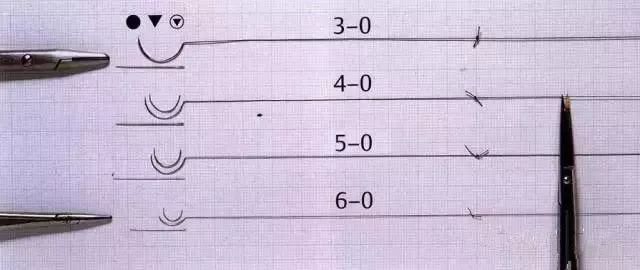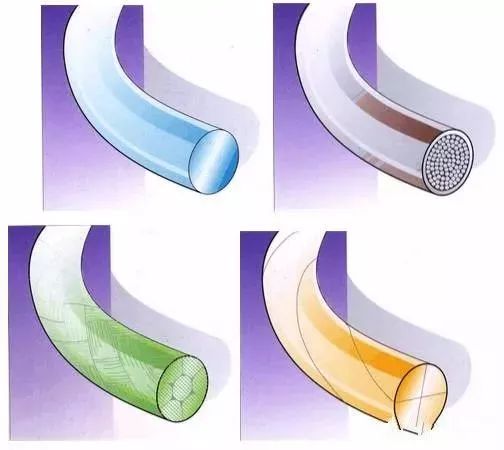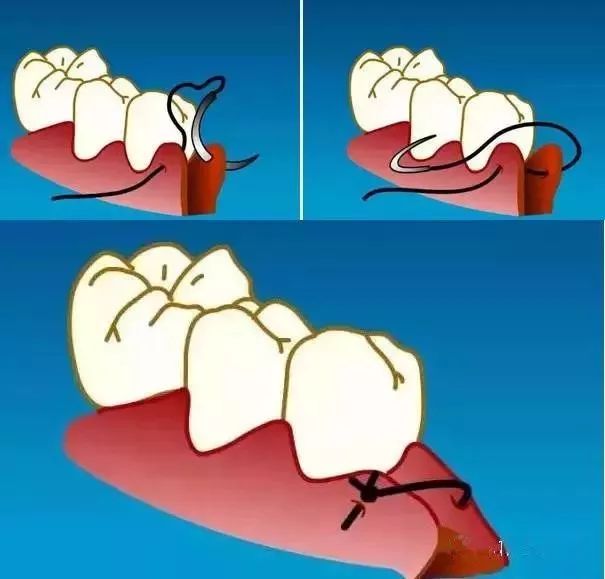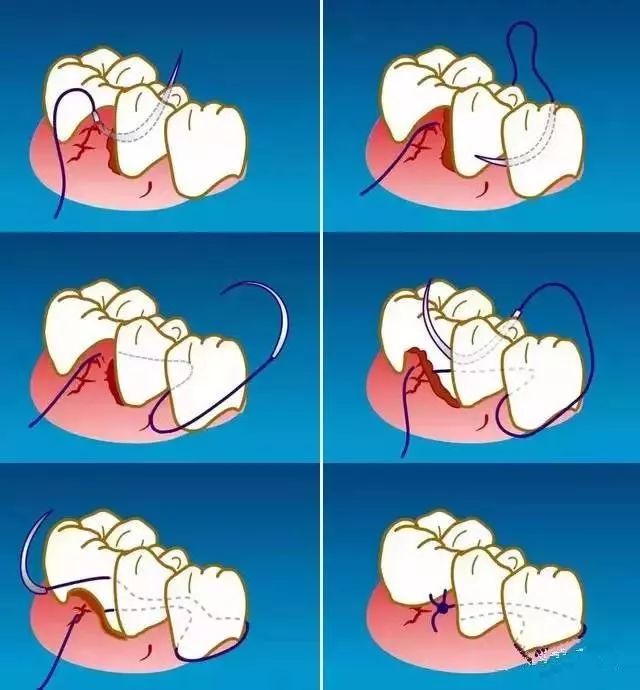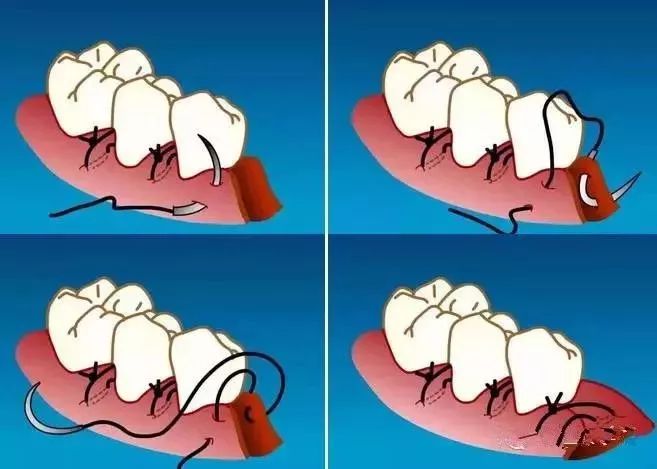Like the incision technique, the suture technique is also the key technique that can determine the success or failure of periodontal surgery. In order to achieve the desired effect of periodontal surgery, a good periodontal suture technique is essential. The purpose of suture is to prevent the exposure of the bone tissue below the soft tissue, eliminate the dead cavity, stop the bleeding, reduce the postoperative discomfort of the patient, keep the gingival flap reduction in the ideal position, and obtain good tissue healing results and beautiful shape of the gums.
One, the type of stitches
There are inverted triangle needle (reverse suture needle), triangle, round needle, etc., its characteristics and uses are different. It is very important to achieve the purpose of surgical healing. The most common needle in periodontal surgery is 3 / 8 circle stitches.
Two, the ideal suture line should have the performance
(1) Good operability;
(2) easy to knot and not easy to slip off;
(3) Convenient for disinfection and packaging;
(4) Appropriate elasticity close to the tissue;
(5) inert materials;
(6) Enough tensile strength to facilitate tissue healing;
(7) Good tissue biocompatibility and degradability.
According to the suture material performance, it is divided into: absorbable suture; non-absorbable suture. According to the production method, it is divided into: small tissue reaction, poor strength; knot: large tissue reaction, high strength. Different sutures have different characteristics and uses.
Three, the common seam is legal
Including periosteal seam legal, discontinuous joint legal, 8 word joint legal, continuous joint legal, vertical / horizontal mattress seam legal, single tooth suspension suture, single intermittent suspension joint legal, continuous (independent) suspension joint legal, anchor joint legal, cross joint legal, locking joint legal, etc.
(1) intermittent suture: is the most commonly used, the most common suture legal.
Continuous seam is suitable for a highly consistent surgical area with equal tension on both sides of the gingival soft tissue.
1. Straight line: mostly used for the distance between both sides of the wound, or the edge of a longer incision.
① Clamp the needle holder to penetrate the soft tissue of the moving wound first. The needle transverses the wound in the tissue, and then penetrates through the soft tissue of the fixed side with equal distance and the same thickness.
② Relax the needle holder, remove the needle, circle the suture around the beak of the needle holder two times, then clamp the free end of the suture with the needle holder, pull the suture ends from the opposite direction, and slide the suture down the beak, and close the two ends of the suture, forming the first knot of the surgical knot.
③ Circle the suture with the needle around the beak of the needle in the opposite direction, then clamp the free end of the suture with the needle holder, and then pull the suture from the opposite direction and tighten the knot to form the second knot of the surgical knot.
④ Such as suture system synthetic material, in order to prevent the surgical knot slip, the third knot can be tied.
⑤ Knotter in the soft tissue wound on the side of the wound. Can not be on the incision, so as not to stimulate the wound, affect the healing.
⑥ The end of the suture left 3-4 mm length, too long hinder patients eating and tongue and cheek movement, too short is easy to fall off the suture release.
2. Crossing method: mostly used for the distance between both sides of the wound, such as the papillary nipple of the posterior teeth.
① Clamp the needle with a needle holder, first penetrate the soft tissue from one side of the wound, then pull the needle to the opposite tooth surface, and repenetrate the wound from the other side.
② Return the needle to the original side of the tooth surface and tie the oblique knot with the free end of the suture.
(2) Suspension suture: it is a suture method to fix the mucosal film suspended on the teeth.
The suspension joint is suitable for the surgical area with different height and unequal tension on both sides of the gingival tissue. It is also suitable for one side of the operation, while the other side is not operated on, so that the two sides of the tension is unequal surgery area. One to several gingival papillae can be fixed, or the mucosal film can be fixed at any height according to the needs of the operation.
1. Single nipple suspension joint is legal: use adjacent teeth to fix a single gingival nipple.
① Pass the needle through the sutured gingival nipple first.
② Pass the needle through the tooth space and around the tongue and neck of the tooth, and then through the middle space of the tooth, make the needle back to the lip (side).
③ After circling the suture around the adjacent tooth, pass from the lingual side through the tooth space back to the original position.
④ Kit the suture at both ends and retain 3-4 mm broken ends.
2. Double nipple suspension joint is legal: use one tooth suspension to fix the seam of two adjacent gingival nipple on the side of the open arch.
① Pass the needle through the far-middle gingival nipple first. Cross the suture ends through the tooth space at the same time.
② Pass the suture around the lingual neck edge of the tooth and through the tooth space at the near middle side, so that both ends of the suture return to the labial side at the same time, and the needle through the gingival nipple at the near middle side.
③ Tighten both ends of the suture and tie the surgical knot.
3. Continuous suspension joint is legal: use multiple teeth to fix multiple gingival papples on one side of the dental arch in an appropriate position.
① The first needle of continuous suspension suture has three different suture methods. The first one is the intermittent suture in the far middle end of the wound, and the free soft tissue only through the wound, with a loose knot; the third one is the free soft tissue only through the wound, but no knot, retaining the free length of the suture end.
② The suture with the needle around the tongue surface and the adjacent tooth space, suture the gingival nipple in turn, tighten it one by one, and fix the gingival nipple in the desired position.
③ The continuous suture of the last stitch has two knot methods. The first type is the single line knot method, which relathe wire sleeve of the last tooth and pulls the double line as the other end of the suture to tie the suture end with the suture needle; the second type is the original knot method, which circles the suture with the needle back to the original position and tie the knot with the free end of the original retained suture.
(3) The mattress seam is legal: it is a method with larger suture tension and longer wound.
Mad suture can protect the subgingival bone graft, reduce the effect of suture on the stimulation of the incision edge or gingival edge, and also better close the long wound with large tension.
1. Horizontal mattress seam is legal
① The needle penetrates into the tissue from 0.5 cm from the incision, follows the direction parallel to the incision in the tissue, and then penetrates the tissue after a distance.
② The suture crosses the incision to the opposite side, and stitches another stitch in the corresponding symmetrical position.
③ The suture again crosses the incision, returned to its original position, and tied the free end of the suture.
④ It is best to stitch the suture at the edge of the wound.
2. Cross mattress type seam is legal
① According to the intermittent suture legal stitch, but not knot.
② Cross the suture of the needle end across the incision, and then return to the original needle side for the second needle interrupted suture.
③ Cross the suture at the needle end through the incision again, return to the original injection point, and tie with the other end of the suture.
④ The edge of the wound is interrupted suture.
3. Vertical mattress type seam is legal
① Several millimeters from the gingival edge, one stitch was stitched in the direction perpendicular to the gingival edge.
② Pass both ends of the suture through the corresponding tooth space at the same time. The patient passes the neck edge of the tooth, and then wears back to the adjacent tooth space on the middle side, so that both ends of the suture come back to the lip side at the same time.
③ Make a second stitch according to the upper method.
④ At both ends of the suture knot, the gingival edge can be smoothly fixed under the double femoral suture.
 Open wechat
Open wechat